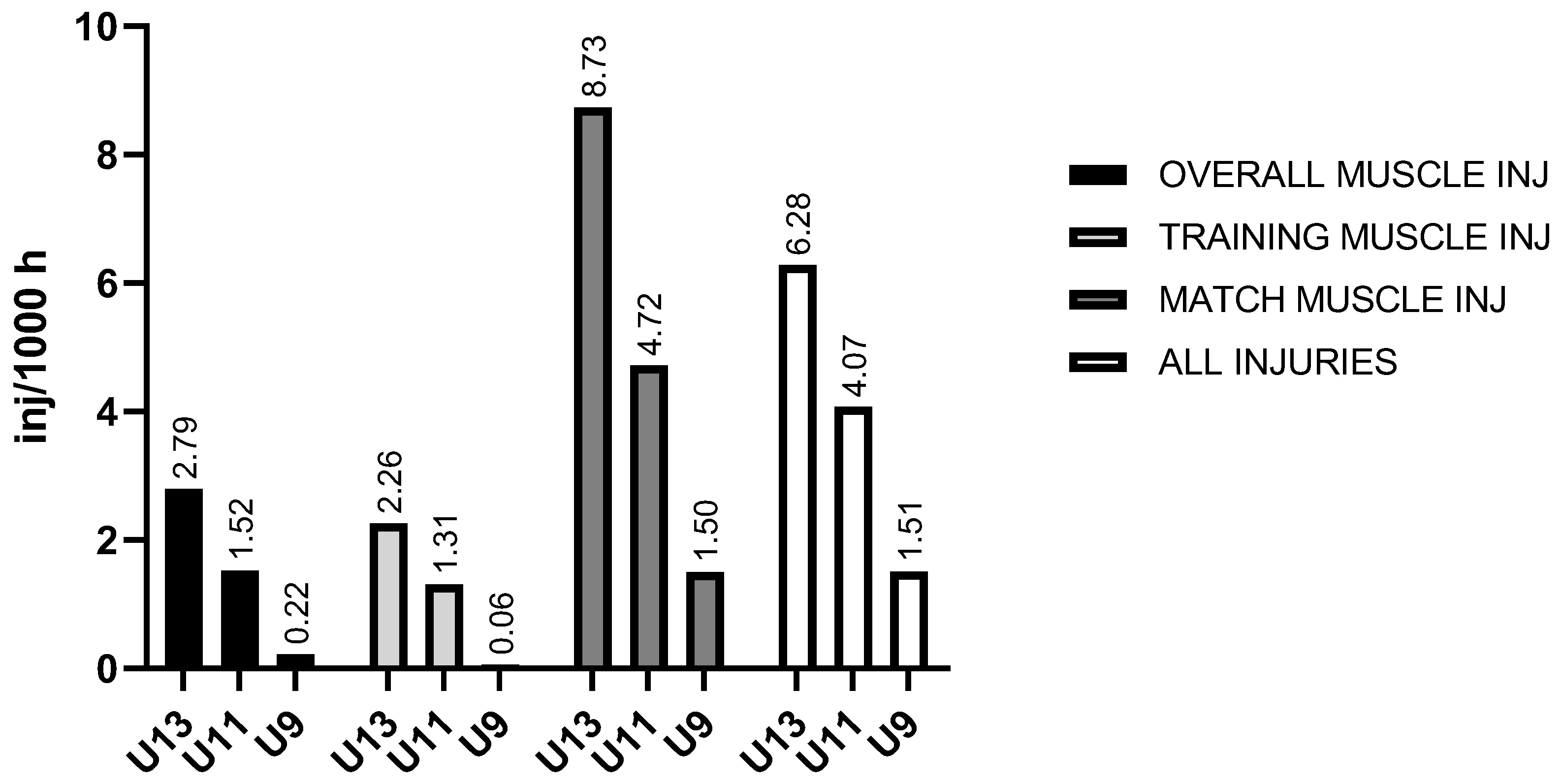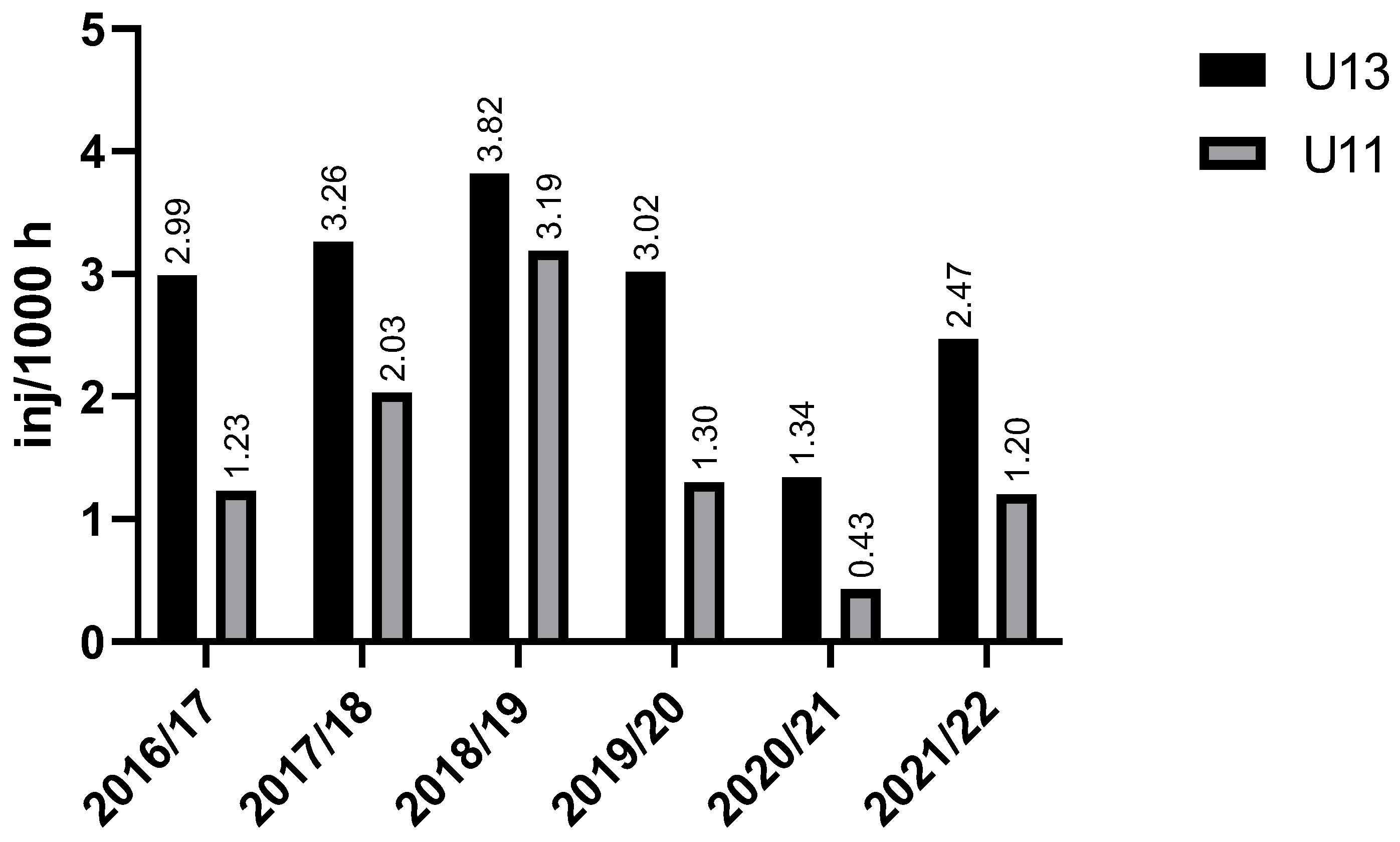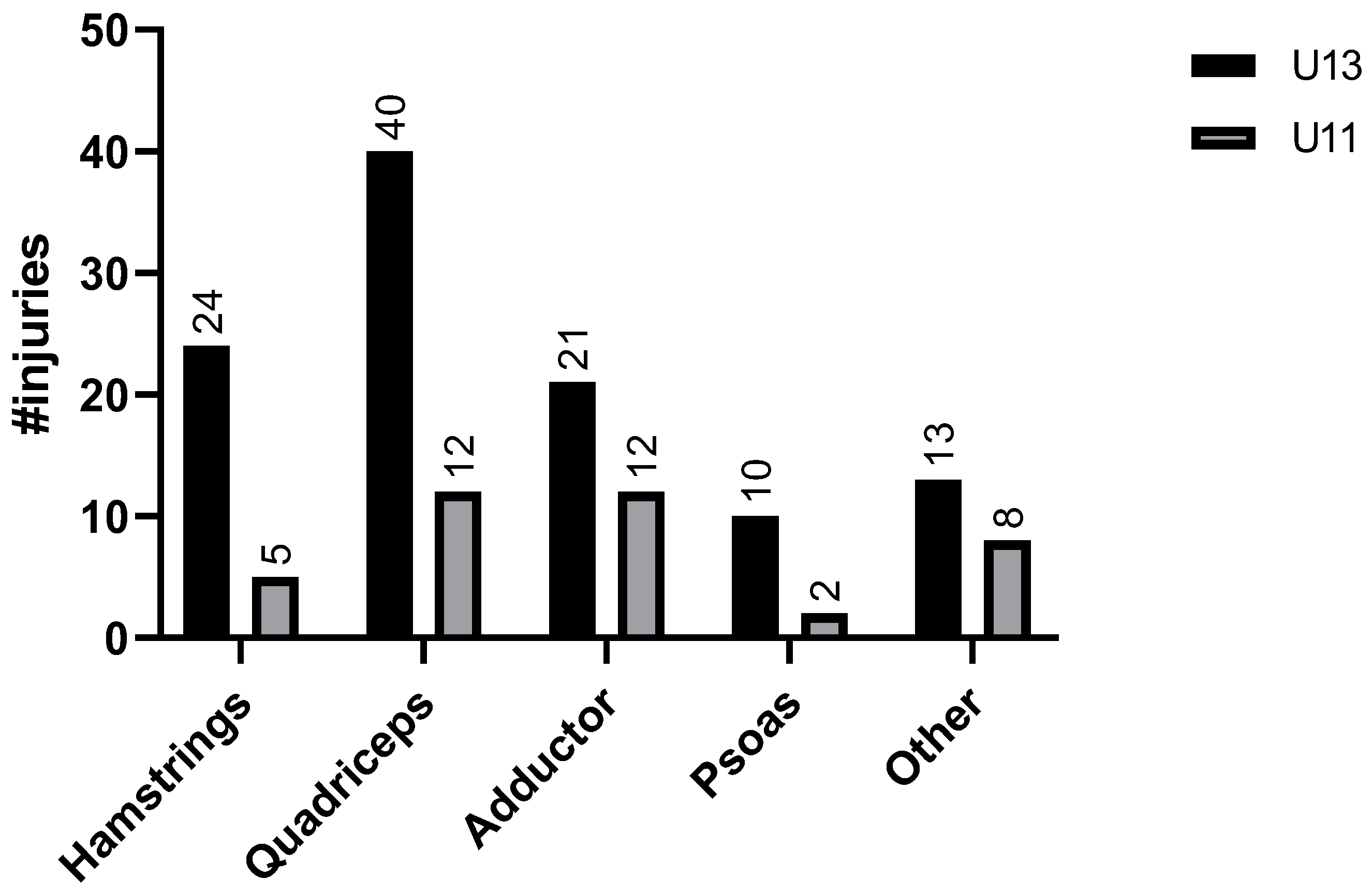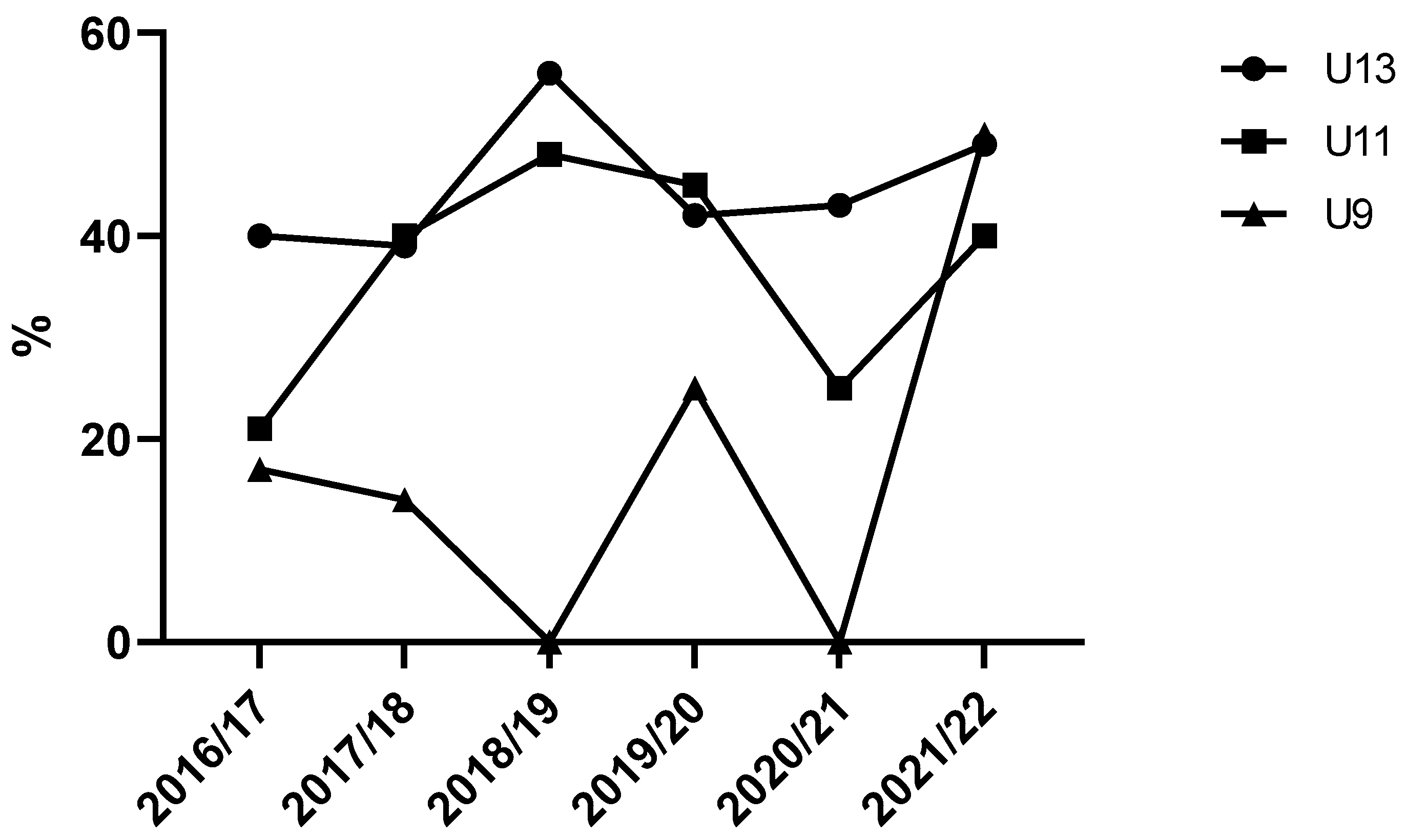Understanding Longitudinal Muscle Injury Trends in Youth Football: Insights from U9 to U13 Players
Abstract
1. Introduction
2. Materials and Methods
2.1. Study Design
2.2. Participants
2.3. Variables
2.4. Statistics
3. Results
4. Discussion
4.1. Injury Incidence
4.2. Location and Type of Injuries
4.3. Proportion of Muscle Injuries
4.4. Strengths and Limitations
5. Conclusions
Author Contributions
Funding
Institutional Review Board Statement
Informed Consent Statement
Data Availability Statement
Acknowledgments
Conflicts of Interest
References
- Clarke, N.J.; Cushion, C.J.; Harwood, C.G. Players’ understanding of talent identification in early specialization youth football. Soccer Soc. 2018, 19, 1151–1165. [Google Scholar] [CrossRef]
- Wrona, H.L.; Zerega, R.; King, V.G.; Reiter, C.R.; Odum, S.; Manifold, D.; Latorre, K.; Sell, T.C. Ability of countermovement jumps to detect bilateral asymmetry in hip and knee strength in elite youth soccer players. Sports 2023, 11, 77. [Google Scholar] [CrossRef] [PubMed]
- Haugaasen, M.; Toering, T.; Jordet, G. From childhood to senior professional football: A multi-level approach to elite youth football players’ engagement in football-specific activities. Psychol. Sport Exerc. 2014, 15, 336–344. [Google Scholar] [CrossRef]
- Teixeira, E.; Silva, C.; Romero, F.; Miguel, M.; Vicente, A. Severe Injuries of Former Portuguese Football Players: A Post-Career Burden? Sports 2025, 13, 17. [Google Scholar] [CrossRef]
- Sweeney, L.; Horan, D.; MacNamara, Á. Premature professionalisation or early engagement? Examining practise in football player pathways. Front. Sports Act. Living 2021, 3, 660167. [Google Scholar] [CrossRef]
- Moseid, C.H.; Myklebust, G.; Fagerland, M.W.; Bahr, R. The association between early specialization and performance level with injury and illness risk in youth elite athletes. Scand. J. Med. Sci. Sports 2019, 29, 460–468. [Google Scholar] [CrossRef]
- Balyi, I.; Hamilton, A. Long-term athlete development: Trainability in childhood and adolescence. Olymp. Coach 2004, 16, 4–9. [Google Scholar]
- Bate, D. Soccer skills practice. Sci. Soccer Lond. E FN Spon 1996, 1996, 227–241. [Google Scholar]
- Rinaldo, N.; Gualdi-Russo, E.; Zaccagni, L. Influence of size and maturity on injury in young elite soccer players. Int. J. Environ. Res. Public Health 2021, 18, 3120. [Google Scholar] [CrossRef]
- Shanmugam, C.; Maffulli, N. Sports injuries in children. Br. Med. Bull. 2008, 86, 33–57. [Google Scholar] [CrossRef]
- Materne, O.; Chamari, K.; Farooq, A.; Weir, A.; Hölmich, P.; Bahr, R.; Greig, M.; McNaughton, L.R. Injury incidence and burden in a youth elite football academy: A four-season prospective study of 551 players aged from under 9 to under 19 years. Br. J. Sports Med. 2021, 55, 493–500. [Google Scholar] [CrossRef] [PubMed]
- Price, R.; Hawkins, R.; Hulse, M.; Hodson, A. The Football Association medical research programme: An audit of injuries in academy youth football. Br. J. Sports Med. 2004, 38, 466–471. [Google Scholar] [CrossRef] [PubMed]
- Bult, H.J.; Barendrecht, M.; Tak, I.J.R. Injury risk and injury burden are related to age group and peak height velocity among talented male youth soccer players. Orthop. J. Sports Med. 2018, 6, 2325967118811042. [Google Scholar] [CrossRef]
- Ekstrand, J.; Hägglund, M.; Waldén, M. Epidemiology of muscle injuries in professional football (soccer). Am. J. Sports Med. 2011, 39, 1226–1232. [Google Scholar] [CrossRef]
- Faude, O.; Rößler, R.; Junge, A. Football injuries in children and adolescent players: Are there clues for prevention? Sports Med. 2013, 43, 819–837. [Google Scholar] [CrossRef]
- Arnason, A.; Sigurdsson, S.B.; Gudmundsson, A.; Holme, I.; Engebretsen, L.; Bahr, R. Risk factors for injuries in football. Am. J. Sports Med. 2004, 32, 5–16. [Google Scholar] [CrossRef]
- Deehan, D.; Bell, K.; McCaskie, A. Adolescent musculoskeletal injuries in a football academy. J. Bone Jt. Surg. Br. Vol. 2007, 89, 5–8. [Google Scholar] [CrossRef]
- Jespersen, E.; Holst, R.; Franz, C.; Rexen, C.T.; Wedderkopp, N. Seasonal variation in musculoskeletal extremity injuries in school children aged 6–12 followed prospectively over 2.5 years: A cohort study. BMJ Open 2014, 4, e004165. [Google Scholar] [CrossRef]
- Costa e Silva, L.; Silva, A.L.; Teles, J.; Fragoso, I. Study on the influence of physical activity intensity and maturation on sports injuries in children and adolescents. Appl. Sci. 2024, 14, 10632. [Google Scholar] [CrossRef]
- Dönmez, G.; Kudaş, S.; Yörübulut, M.; Yıldırım, M.; Babayeva, N.; Torgutalp, Ş.Ş. Evaluation of muscle injuries in professional football players: Does coach replacement affect the injury rate? Clin. J. Sport Med. 2020, 30, 478–483. [Google Scholar] [CrossRef]
- Emery, C.A.; Roy, T.-O.; Whittaker, J.L.; Nettel-Aguirre, A.; Van Mechelen, W. Neuromuscular training injury prevention strategies in youth sport: A systematic review and meta-analysis. Br. J. Sports Med. 2015, 49, 865–870. [Google Scholar] [CrossRef] [PubMed]
- Keemss, J.; Sieland, J.; Pfab, F.; Banzer, W. Effects of COVID-19 lockdown on physical performance, sleep quality, and health-related quality of life in professional youth soccer players. Front. Sports Act. Living 2022, 4, 875767. [Google Scholar] [CrossRef] [PubMed]
- Vincent, H.K.; Patel, S.; Zaremski, J.L. Impact of COVID on sports injury patterns, changes in mental well-being, and strategies to prepare for future pandemics in sport. Curr. Sports Med. Rep. 2022, 21, 196–204. [Google Scholar] [CrossRef]
- Stokes, K.A.; Jones, B.; Bennett, M.; Close, G.L.; Gill, N.; Hull, J.H.; Kasper, A.M.; Kemp, S.P.; Mellalieu, S.D.; Peirce, N. Returning to play after prolonged training restrictions in professional collision sports. Int. J. Sports Med. 2020, 41, 895–911. [Google Scholar] [CrossRef]
- Geldenhuys, A.G.; Burgess, T.; Roche, S.; Hendricks, S. Return to play protocols for musculoskeletal upper and lower limb injuries in tackle-collision team sports: A systematic review. Eur. J. Sport Sci. 2022, 22, 1743–1756. [Google Scholar] [CrossRef]
- Light, N.; Johnson, A.; Williams, S.; Smith, N.; Hale, B.; Thorborg, K. Injuries in youth football and the relationship to player maturation: An analysis of Time-Loss injuries during four seasons in an English elite male football academy. Scand. J. Med. Sci. Sports 2021, 31, 1324–1334. [Google Scholar] [CrossRef]
- Ergun, M.; Denerel, H.N.; Mehmet, S.; Ertat, K.A. Injuries in elite youth football players: A prospective three-year study. Acta Orthop. Et Traumatol. Turc. 2013, 47, 339–346. [Google Scholar] [CrossRef]
- Wik, E.H.; Lolli, L.; Chamari, K.; Materne, O.; Di Salvo, V.; Gregson, W.; Bahr, R. Injury patterns differ with age in male youth football: A four-season prospective study of 1111 time-loss injuries in an elite national academy. Br. J. Sports Med. 2021, 55, 794–800. [Google Scholar] [CrossRef]
- Pfirrmann, D.; Herbst, M.; Ingelfinger, P.; Simon, P.; Tug, S. Analysis of injury incidences in male professional adult and elite youth soccer players: A systematic review. J. Athl. Train. 2016, 51, 410–424. [Google Scholar] [CrossRef]
- Medeiros, D.M.; Marchiori, C.; Baroni, B.M. Effect of Nordic hamstring exercise training on knee flexors eccentric strength and fascicle length: A systematic review and meta-analysis. J. Sport Rehabil. 2020, 30, 482–491. [Google Scholar] [CrossRef]
- Dupré, T.; Potthast, W. Groin injury risk of pubertal soccer players increases during peak height velocity due to changes in movement techniques. J. Sports Sci. 2020, 38, 2661–2669. [Google Scholar] [CrossRef] [PubMed]
- Renshaw, A.; Goodwin, P.C. Injury incidence in a Premier League youth soccer academy using the consensus statement: A prospective cohort study. BMJ Open Sport Exerc. Med. 2016, 2, e000132. [Google Scholar] [CrossRef] [PubMed]




| # Injuries | Days Out | Reinjury | Occurrence | Contact | |||
|---|---|---|---|---|---|---|---|
| Training | Match | ||||||
| U13 | Rupture | 27 | 24.5 | 14 | 18 | 9 | 5 |
| DOMS | 68 | 8.4 | 3 | 54 | 14 | 5 | |
| Contusion | 13 | 5.4 | 4 | 8 | 5 | 13 | |
| Total | 108 | 12.8 | 21 | 80 | 28 | 23 | |
| U11 | Rupture | 12 | 25.5 | 2 | 8 | 4 | 4 |
| DOMS | 26 | 8.9 | 4 | 20 | 6 | 2 | |
| Contusion | 2 | 6 | 0 | 2 | 0 | 2 | |
| Total | 39 | 13.5 | 6 | 30 | 10 | 8 | |
| U9 | Rupture | / | / | / | / | / | / |
| DOMS | 4 | 7.3 | 0 | 1 | 3 | 0 | |
| Contusion | / | / | / | / | / | / | |
| Total | 4 | 7.3 | 0 | 1 | 3 | 0 | |
Disclaimer/Publisher’s Note: The statements, opinions and data contained in all publications are solely those of the individual author(s) and contributor(s) and not of MDPI and/or the editor(s). MDPI and/or the editor(s) disclaim responsibility for any injury to people or property resulting from any ideas, methods, instructions or products referred to in the content. |
© 2025 by the authors. Licensee MDPI, Basel, Switzerland. This article is an open access article distributed under the terms and conditions of the Creative Commons Attribution (CC BY) license (https://creativecommons.org/licenses/by/4.0/).
Share and Cite
Skomrlj, J.; Modric, T.; Sekulic, D.; Kuko, M.; Cikojević, L.; Bandalovic, A.; Turic, A.; Becir, B.; Veršić, Š. Understanding Longitudinal Muscle Injury Trends in Youth Football: Insights from U9 to U13 Players. Sports 2025, 13, 163. https://doi.org/10.3390/sports13060163
Skomrlj J, Modric T, Sekulic D, Kuko M, Cikojević L, Bandalovic A, Turic A, Becir B, Veršić Š. Understanding Longitudinal Muscle Injury Trends in Youth Football: Insights from U9 to U13 Players. Sports. 2025; 13(6):163. https://doi.org/10.3390/sports13060163
Chicago/Turabian StyleSkomrlj, Jaksa, Toni Modric, Damir Sekulic, Mate Kuko, Luka Cikojević, Ante Bandalovic, Ante Turic, Boris Becir, and Šime Veršić. 2025. "Understanding Longitudinal Muscle Injury Trends in Youth Football: Insights from U9 to U13 Players" Sports 13, no. 6: 163. https://doi.org/10.3390/sports13060163
APA StyleSkomrlj, J., Modric, T., Sekulic, D., Kuko, M., Cikojević, L., Bandalovic, A., Turic, A., Becir, B., & Veršić, Š. (2025). Understanding Longitudinal Muscle Injury Trends in Youth Football: Insights from U9 to U13 Players. Sports, 13(6), 163. https://doi.org/10.3390/sports13060163










